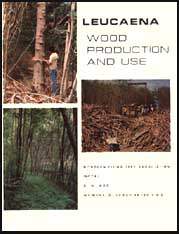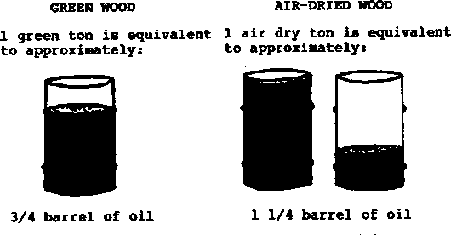8-1 PROPERTIES OF WOOD
Leucaena produces a medium density (bolewood specific gravity = 0.54), pale yellow sapwood with light reddish heartwood. It machines easily, and is without irritant or tooldulling properties. The wood takes water-soluble preservatives (e.g., pentachlorophenol) readily, and is of low-tomoderate durability. It dries without splitting or checking.
Giant varieties of leucaena are the most suitable for wood use. They are largely self-pruning in dense plantations, and forking is rare and can be eliminated by pruning. Trees on plantation borders show drastic butt sweep, leaning into areas of greater sunlight. Clear boles of 5 m must be considered very rare, and the tree generally is too irregular to be particularly attractive for long sawtimber or telephone poles.
Leucaena wood has generally high ratings as a source of fuelwood; pulpwood, rayon, postwood, wood for parquet flooring and for craftwork, and particleboard. As supply is increased, other optional end-uses are expected to develop. It is evident that the giant leucaenas have opened to users a variety of options not available with the common types.
The pressure of human over-population on land use is often felt as a fuel shortage before it is felt as food shortage. This has led in some instances to disastrous deforestation and soil degradation problems, which often occur before their seriousness is fully recognized. A major value of leucaena is that it can rapidly provide fuelwood, removing pressure from existing forests and wood resources.
In rural areas, fuelwood use combines well with animal feeding. Whole leucaena branches are given to penned animals which strip the leaves and twigs. The defoliated stems dry rapidly, and can then be cut for fuel. The net heating value of leucaena wood varies greatly with moisture content, so that drying of the wood to 25% moisture content (wet basis) before burning will be equivalent to increasing wood yields yield by 50% (Figure 8-1).
The calorific value of air-dried (15% m.c. wet basis) leucaena wood is about 3,900 kcal/kg (4,640 kcal/kg oven dried), similar to that of other non-resinous hardwoods. The burning properties are good (steady flame, low smoke and sparks). The major value of leucaena is still associated with its high productivity as a fuelwood, and this applies to both village and industrial use.
Figure 8-1 Fuel value yields can be greatly improved by drying
Large-scale industrial development of leucaena fuelwood plantations is already in progress. The most spectacular example is the construction in the Philippines of a number of dendro-thermal power plants, in which 3-5 mW, wood-fired steam turbine generators are fueled directly from adjoining plantations. Most of the environmental problems associated with fossil fuels, geothermal, or nuclear plants do not apply to wood-fired plants, and the technology is already proven and available. Economic feasibility depends largely on land quality and production costs in relation to the costs of other energy sources.
When wood is converted to charcoal, there is a 50-70% loss of energy overall, but the product has nearly double the heating value of wood. This compactness and its clean, smokeless burning properties give charcoal many fuel-use advantages. There is a traditional urban demand for charcoal as a cooking fuel which may increase as oil products become more expensive. Leucaena makes a clean and high-quality charcoal, and is being used in gasifiers. When produced to uniform specifications, it can also have industrial uses as an activated and reducing carbon source. Conversion of wood to charcoal is likely to be most appropriate on difficult sites where wood transport is uneconomical.
8 - 3 PULP
Leucaena is well suited to the production of either paper pulp or dissolving pulp. The bark is thin (8% of dry weight at age 7) and easily removed. Silica and extractives contents are low (2% dry weight), thus minimizing consumption of alkalai in chemical pulping. The holocellulose content (71%) is somewhat higher than the average for hardwoods (64%). Fiber characteristics are within the range expected for fast-growing tropical hardwoods.
The main use of leucaena pulp is to blend with long-fibre pulp for production of printing papers. The fiber is also useable for rayon and other products. Because pulping operations must be on a large scale and are highly sensitive to the cost of wood, development of Leucaena plantations for this purpose must be closely integrated with requirements of the pulping plant.
8 - 4 ROUNDWOOD
Rapid height growth and generally good form make leucaena ideal for small pole production. Untreated roundwood is not durable on ground contact, however, it readily absorbs waterborne preservatives (copper-chromearsenate), or creosote-based compounds. Treated posts can be used for fences or light construction.
Pole houses, traditional in Asia, may provide an additional use for leucaena poles. A major market has already developed for leucaena poles 4 m in length with diameters 3-7 cm as banana props. Leucaena poles are also used as supports in the cultivation of vanilla, pepper, climbing beans and yams. Some use is made of the larger trees for telephone or power transmission poles.
8 - 5 LUMBER
Plantation-grown giant Leucaena can produce a medium hardwood with good working properties. Good recoveries are possible even with 7 year old trees. For example, a 24 cm diameter log gave a recovery of 62% when sawn to 2.5 cm thickness. The stems are usually defect-free, but no definitive grade or recovery studies appear to have been made.
The sawn wood has been used successfully in parquet flooring. It also produces suitable wood for small furniture. Colors are light in the sapwood, with the heartwood ranging to deeper yellows and light reds on aging, and are considered quite attractive.

